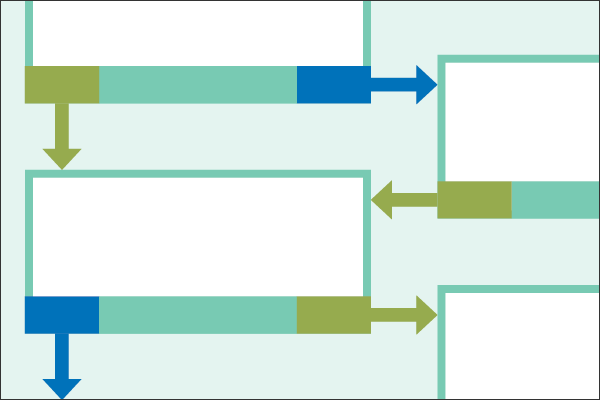
Bill 11, Fair Registration Practices Act and Fair Registration Practices Regulation
On June 19, 2019, the government of Alberta introduced Bill 11, Fair Registration Practices Act, through the Ministry of Labour and Immigration. On November 26, 2019, the government of Alberta made the Fair Registration Practices Regulation set out in the Act. This new legislation sets up a Fair Registration Practices Office for the purpose of ensuring registration practices are transparent, objective, impartial, and fair.
Fall 2019 Student Presentations
The Strategic Plan approved by the Council provides the College direction to “connect and inspire members to foster and instill commitment to both the public and the practice of the profession.” In line with this direction, the College has an outreach program for its student members. The program inspires students to get involved in their profession through the conference and participation in branch activity, completing the Regulations Education Module and contacting College staff directly regarding professional practice.
The College met with magnetic resonance, radiological technology, nuclear medicine, diagnostic medical sonography and radiation therapy students at NAIT, SAIT and University of Alberta. Our Director of Education and Competence, Alefiyah Gulamhusein, and Director of Policy and Practice, Ugie Ifesi, delivered presentations and held conversations about the legislative framework, the importance of self-regulation, and the College – the registration process, the continuing competence program, and the complaints process. The event ended with a 15-question Kahoot! game and prizes. Based on the survey collected from all students, the events were successful.
Celebrating MRT Week 2019
From November 3 to 9, 2019, we celebrated the integral role our MRTs play in our healthcare system for MRT Week.
In preparation for MRT Week, we mailed packages to 263 sites across the province that included several posters, tent cards and bookmarks. The tent cards are meant to be displayed in areas where patients will see them so they can learn more about who MRTs are and what they do. We didn’t mention MRT Week on the tent cards in the hopes that they would be displayed longer. Please contact us if you’re interested in receiving more tent cards or bookmarks.
We also posted on Facebook and Twitter every day during MRT Week, each post highlighting a different aspect of the profession. We were very happy with the response to these posts and appreciate all the shares.
While MRT Week is only celebrated once a year, we recognize and appreciate the hard work and dedication of our MRTs all year round. Thank you for your important contribution to ensuring Albertans receive safe, competent and ethical diagnostic and therapeutic care!
Diagnostic Medical Sonographers (DMS) Roster Update
The Alberta DMS Roster managed by this College was launched in the fall of 2017, and it is nearly 1,000 professionals strong. The College would like to encourage DMS who have not yet rostered to volunteer to do so by sending their completed application to the College. For information on rostering and the status of DMS in Alberta, visit our DMS web page.
The College continues to work with Alberta Health to expedite the regulatory changes needed to regulate DMS in Alberta. Mandatory registration/regulation of DMS will start once the regulation comes into effect.
Systems Upgrade
The College’s database required for membership maintenance and management services is scheduled for upgrade in 2020. This upgrade will ensure the continued capacity of the College to serve the public interest and regulatory compliance. It will also offer improved member experience through a redesigned portal providing new options to download permits, receipts, invoices and online applications for registration.
Branch education event: pilot digital broadcast
ACMDTT branches promote the College’s interest in membership services through providing opportunities for education, networking, and discussion. Branch Chairs met during the conference in April 2019 and conceived the idea of collaborating to bring education to members across the province. They worked through the summer to deliver an education event held in Edmonton and streamed live on September 21, 2019, to these sites:
- Calgary Foothills Medical Centre
- Lethbridge Chinook Regional Hospital
- Medicine Hat Regional Hospital
- Red Deer Hospital
- Valleyview Health Centre
- Fort McMurray Northern Lights Health Centre
- Grande Cache Community Health Complex
- McLennan Sacred Heart Community Health Centre
The College appreciates the enthusiasm and responses from the Branch Chairs and members who attended the event to make this pilot project successful. These collaborative efforts are vital to promoting MRT and ENP professional growth and development and provide excellent network opportunities to the profession. The Chairs are meeting early in the new year to discuss future collaborations.
Renewal
Over 97% of members have renewed by completing all of the legally mandated registration requirements to practice the profession in Alberta in 2020. This reflects that you understand the importance of regulatory compliance as self-regulated professionals and illustrates your respect for your profession along with your dedication to ensuring that Albertans receive safe, competent, and ethical diagnostic and therapeutic care.
If you have not renewed, please know that as of January 1, 2020:
- If you plan to practice as an MRT or ENP in Alberta, your practice permit will be administratively suspended, and you must cease practice. You will have to contact the College to renew your practice permit. Also, all additional and enhanced authorizations that have not been renewed will be cancelled.
- If you do not plan to practice as an MRT or ENP in Alberta, your Associate membership will expire automatically and you will need to meet all general registration requirements in place at the time of your application before you can apply for the associate membership.
- If you are changing registration status, you will need to complete the process through College staff before completing renewal.
For more information, please visit our Renewals web page. Please note that the College is closed from Monday, December 23, 2019, to Wednesday, January 1, 2020, and will reopen on Thursday, January 2, 2020.
Questions
If you have any renewal related renewal questions or concerns, please contact the College at 780.487.6130 or 1.800.282.2165, or by email at registration@acmdtt.com.
 The College is pleased to launch its new Decision-Making Tool for members.
The College is pleased to launch its new Decision-Making Tool for members.
Our primary purpose as a regulatory body is the protection of the public, and our practicing members are key to delivering this mandate as they are the ones who actually interact with the public every day. This means the main way we can protect the public is by effectively communicating important regulatory information with our members in a meaningful and useful way.
With this in mind, the College undertook a project with the goal of finding ways to communicate more proactively with members. After researching communication best practices and completing an environmental scan to see what other organizations are doing, we decided to create a tool that would empower our members to make sound, informed decisions in their practice.
The Decision-Making Tool we’re sharing today is the result of a comprehensive process that included consultation with regulated members and experts, an initial draft, a focus group and several significant revisions. The final product includes a series of questions to guide the regulated member in determining if a specific activity is appropriate and safe for them to perform.
The tool also provides descriptions of and links to key foundational documents for the regulated member to consult for additional information. The documents referred to in this tool are the Health Professions Act (HPA), Medical Diagnostic and Therapeutic Technologists Profession Regulation (the Regulation), Code of Ethics, Standards of Practice and competency profiles. We’ve created a Resources page on our website that links to all these documents in one place and includes the relevant passages from the HPA and the Regulation for ease of use.
You can access the Decision-Making Tool in both print and digital formats. The print PDF includes a visual representation of the tool and a summary of information, and you can refer to either the Appendices PDF or the Resources web page for further details if necessary. The digital version is interactive (clicking “Yes” or “No” brings you to the next appropriate step), and each page includes all relevant details.
We’ll continue to update the tool as necessary to ensure it reflects the current environment. For example, we’ll need to revise it when we begin regulating diagnostic medical sonographers and any time new legislation affects our policies and standards.
We invite you to explore the Decision-Making Tool by navigating the interactive example included with this issue’s Perspectives scenario and by considering how it would address questions specific to your professional practice.
We hope you find this tool useful and we welcome any feedback you’d like to share. There’s a short survey you can complete after using the tool, or you can contact us directly. And as always, we’re happy to answer any practice questions you have — please feel welcome to call us at 780.487.6130 or email practiceadvisor@acmdtt.com.
By Andra Morrison, Canadian Agency for Drugs and Technologies in Health (CADTH)
 Artificial intelligence (AI) can help us in our everyday lives – from improving our email communications, to searching the web, even recommending products or music we might enjoy. In health care, AI is improving the way we detect illnesses or certain health conditions. But what about the use of AI in medical imaging?
Artificial intelligence (AI) can help us in our everyday lives – from improving our email communications, to searching the web, even recommending products or music we might enjoy. In health care, AI is improving the way we detect illnesses or certain health conditions. But what about the use of AI in medical imaging?
CADTH’s Health Technology Update newsletter highlights new and emerging health technologies. In Issue 22 (October 2018), CADTH Program Development Officer Andra Morrison explores the use of artificial intelligence for stroke in the emergency setting. The article takes a closer look at e-ASPECTS (Brainomix Limited), an artificial intelligence enhanced decision support tool, which can be used for patients with suspected stroke to measure the extent of ischemic damage.
To read the issue in full, visit https://cadth.ca/health-technology-update-issue-22
If you’d like to learn more about CADTH, visit www.cadth.ca. You can also follow them on Twitter @CADTH_ACMTS or contact Genevieve Chartrand, Alberta Liaison Officer (GenevieveC@cadth.ca).
 The Radiation Therapy Department at the Tom Baker Cancer Centre (TBCC), under the directorship of an experienced radiation oncologist/world-class breast researcher and his fourth-year resident, put forth to the Health Research Ethics Board Alberta-Cancer Care (HREBA-CC) Accelerated Partial Breast Irradiation Using Five Daily Fractions: A Single Arm, Phase II, Prospective Cohort Study to Examine Cosmetic Outcomes and Toxicity (the ACCEL Trial) for review and approval.
The Radiation Therapy Department at the Tom Baker Cancer Centre (TBCC), under the directorship of an experienced radiation oncologist/world-class breast researcher and his fourth-year resident, put forth to the Health Research Ethics Board Alberta-Cancer Care (HREBA-CC) Accelerated Partial Breast Irradiation Using Five Daily Fractions: A Single Arm, Phase II, Prospective Cohort Study to Examine Cosmetic Outcomes and Toxicity (the ACCEL Trial) for review and approval.
Prior to the submission of the protocol, an experienced clinical research radiation therapist, who was a past research grantee and had prior publications, was involved with the creation of all the HREBA-CC approved documents. That early participation/teamwork created the basis for a rock-solid ACCEL research team. This team included all of the breast radiation oncologists, radiation therapists, dosimetrists, medical physicists and radiation therapy (RT) nurses.
In March 2016, HREBA-CC gave full board approval for the ACCEL Trial. The team had expected that this would occur, so a workshop was scheduled at the TBCC in April 2016 for the ACCEL Trial with the aim to educate and train all of the health-care professionals for each specific area/task. This was done because there would be two new community cancer centres, Red Deer Cancer Centre (RDCC) and the Jack Ady Cancer Centre (JACC) in Lethbridge, that would not only open the ACCEL Trial in their respective departments, but would also establish a research department. The ACCEL workshop was facilitated by the research radiation therapist and the radiation oncologist (principal investigator).
The workshop was successful, and the first official partial breast patient was recruited at the TBCC in May 2016. The protocol defines the criteria for eligibility for the ACCEL Trial patients. The process that was used is described below.
During the breast consultation with the patient, the radiation oncologist provided an introduction to the ACCEL Trial and described the risks and benefits of whole breast RT versus the partial breast RT. At the conclusion of the consultation, the patient was given the consent form package to take home and read. Prior to contacting the referred patient, the research radiation therapist verified 25 parameters that determined eligibility for the ACCEL Trial. The research radiation therapist called the potential ACCEL patient, explained the ACCEL Trial and provided a verbal descriptive picture to illustrate the radiation treatments.
Once verbal consent was obtained, the research therapist scheduled the consent process one hour before the CT simulation. The following tasks were completed during this process:
- PowerPoint presentation specifically for ACCEL Trial patients.
- Research radiation therapist encouraged Q&A discussion regarding the Trial before the patient signed the consent form.
- Authorization from the patient to palpate (touch) along seroma (surgical site plus 7 mm margin) incision to assess the extent of fibrosis.
- Two digital photographs were taken of both breasts as per protocol and for future cosmesis evaluation.
- Both the patient and the research radiation therapist performed a cosmetic assessment of the affected breast as compared to the contra-lateral breast.
- When the consent process achieved all of the tasks as outlined above, the patient was taken to the CT simulator. The patient underwent a CT scan of the affected breast and contra-lateral breast. This 3D data was used to plan the dosimetric parameters to the prescribed treatment volume.
Once the consent process and CT simulation had been completed, the next step in the ACCEL Trial was for the research radiation therapist to download and secure the digital clinical photographs in the Research Electronic Data Capture (REDCap) database. This was created by the University of Calgary Clinical Research Unit (CRU). All the digital pictures were resized and labelled to be identified through a numbering system (as per protocol) to ensure the patient’s confidentiality was maintained.
The cosmetic worksheet the patient and research radiation therapist completed during the consent process was entered into the patient’s file in REDCap. All information was secured and all researchers in the ACCEL Trial abide by the good clinical practice (GCP) standards.
When the ACCEL patient arrived for radiation therapy, the seroma received a daily tumor dose (DTD) of 5.4 Gy per treatment (TTD=total tumor dose of 27 Gy/5 fractions). The radiation oncologist saw the patient once during their five radiation treatments and at the patient’s first follow-up appointment 6-8 weeks after the last treatment. The ACCEL patient is seen at one year and finally at two years post-treatment. Completion of the ACCEL Trial redirects the follow-up care to the patient’s family physician for annual assessments and mammography.
The ACCEL Trial started in May 2016 and concluded in October 2019. 294 patients were recruited for the ACCEL Trial. To date, this is an effective alternative to the standard whole breast RT. However, there is one caveat: this is only applicable to those with very early staged breast cancer (no lymph node involvement), which statistically contributes to ~30% of the breast patient population.
The next step for patients is to attend the follow-up appointments so that both the clinical assessment by the radiation oncologist and radiation therapist can be completed as per the ACCEL Trial protocol.
The ACCEL Trial is a success story for the Radiation Therapy Department at the TBCC because of the teamwork and support of all the radiation therapists and the management team. This research was done with the assistance of many, many healthcare professionals (some from the ACMDTT) and other professional groups.
The future of partial breast RT is promising, as much of the radiation oncology world already uses this treatment. There are discussions of an upcoming Canadian research trial that will compare partial breast to whole breast on a national stage.
 College regulation states that in each registration year, a self-regulating professional needs to complete the Continuing Competence Program (CCP). The CCP requires that a regulated member complete, in each registration year, a reflective practice review that consists of a self-assessment, a learning plan, and a minimum of 24 hours of learning activities with details of how the learning was useful to the professional. The CCP is founded on the assumption that regulated members acquire appropriate skills and knowledge to practice the profession through their educational programs, then maintain these competencies through lifelong learning and adherence to the Standards of Practice as self-regulated professionals.
College regulation states that in each registration year, a self-regulating professional needs to complete the Continuing Competence Program (CCP). The CCP requires that a regulated member complete, in each registration year, a reflective practice review that consists of a self-assessment, a learning plan, and a minimum of 24 hours of learning activities with details of how the learning was useful to the professional. The CCP is founded on the assumption that regulated members acquire appropriate skills and knowledge to practice the profession through their educational programs, then maintain these competencies through lifelong learning and adherence to the Standards of Practice as self-regulated professionals.
The legislation also establishes the Competence Committee consisting of regulated members of the profession and charges it with the responsibility to:
- Monitor the components of the Continuing Competence Program (CCP) by reviewing the program every five years in order to accurately reflect current needs and to enhance the provision of professional services
- Monitor individual registered members’ compliance with the continuing competence requirements (CCP audit)
The CCP was reviewed in 2014, and this year’s scheduled review was kicked off by presentations from our colleagues in Ontario and Alberta – the College of Medical Radiation Technologists of Ontario (CMRTO) and the Alberta College of Combined Laboratory and X-Ray Technologists (ACCLXT), respectively – about the purpose and goal of continuing competence programs. Throughout our careers, we are expected to maintain the initial competencies learned at our post-secondary institutions and improve them through lifelong learning. All healthcare competence programs are based on adult learning; this means that individuals are best able to identify what their professional development needs are, as well as what their preferred learning style is. Representatives from both organizations stressed that their competence programs were fair to all members and not meant to be punitive.
Providing feedback to audited members is very important to the Committee. As they go through the audit, the Committee wants to share areas where members can improve their CCP for future learning years. One of the ways to achieve this is by adding a feedback form directly in the MyCCP portal. This allows the Committee to share what is required for your CCP submission to be successful, such as identifying all indicators in your self-assessment, identifying two learning objectives and how one was met with a learning activity, and including all necessary information in your CCP activity records (such as date, title, presenter, learning content and how the learning was useful to the member’s practice). The form summarizes total hours and allows the Committee to enter additional comments regarding the submission. This form is only shared with members to whom the Committee wants to provide feedback.
The Competence Committee also reviewed and updated the CCP policies and terms of reference. A new Competence Committee Manual was approved that holds updated and new policies such as Requests for Extension or Exemption, Member Status for Audits and more. Members can be assured of consistency, fairness and transparency throughout our CCP processes.
Moving forward to 2020, the College strives to revitalize the language on the CCP section of the ACMDTT website and the MyCCP portal to be more user friendly. We will also look at providing education through webinars to the membership about aspects of the Continuing Competence Program.
The Continuing Competence Guide has been updated for 2019-2020 and is available on our website and on the MyCCP portal.
Morgan is a radiological technologist working in an interventional radiology department. The attending radiologist gives an order for the administration of heparin, an anticoagulant.
Is this activity within Morgan’s scope of practice?
The ACMDTT has approval for members to perform some/all of the restricted activities, as identified in the Medical Diagnostic and Therapeutic Technologists Profession Regulation (the Regulation). Currently, only radiological technologists who hold a current and valid medication administration enhanced practice authorization on their practice permit may prepare and/or administer medications as part of their practice.
What training does Morgan have to do in order to perform this activity?
A College-approved program is required in order for Morgan to prepare and administer medication. This authorization provides that the regulated member has ensured they have the education and competence to perform the activity in compliance with the ACMDTT Regulation, Standards of Practice and Code of Ethics (as listed below) and employer policy.
Morgan should ask:
- Do I have the knowledge to perform this competently? (i.e. consider clinical procedures, pharmacology, adverse events)
- Do I have skills to perform this competently? (i.e., understanding contraindications, administration routes, administration rates, handling medications, identifying and handling adverse events)
What Standards of Practice apply to this scenario?
Standard 1.2 Clinical Procedures
To demonstrate this Standard, a regulated member will:
- possess the necessary competence to perform the procedure safely, effectively and ethically
- ensure patient safety
- identify and communicate with the appropriate healthcare provider any procedural concerns
Standard 2.3 Restricted Activities/Enhanced Practice
To demonstrate this Standard, a regulated member will:
- Perform only those restricted activities for which he or she has the required competence and current authorization.
- Assess the benefits and risks associated with performing the restricted activity.
- Be responsible and accountable for safely performing the restricted activity.
- Understand the risks associated with performing the restricted activity and ensure that measures are in place to manage any critical or unexpected events associated with performing it.
Standard 4.2 Safe Practice
To demonstrate this Standard, a regulated member will:
- Apply the applicable standards for the handling, use, storage and disposal of materials.
- Apply the appropriate infection prevention and control standards to prevent contamination of persons, equipment and environment.
- Seek clarification of orders where a patient safety issue has been identified.
Code of Ethics
Principle 3 Responsibility to oneself
- Accountability
- A regulated member takes responsibility and is accountable for his/her professional activities.
We recently interviewed Wendy Read, who retired from practicing radiation therapy this year and served as our Council president from 2013-2015. Watch a short video on her thoughts on current trends in medical radiation technology below or watch the full interview on YouTube.

Please note the office will be closed from December 23, 2019, to January 1, 2020, and will reopen on January 2, 2020.
The ACMDTT staff wish you and your family a safe and happy holiday season!
